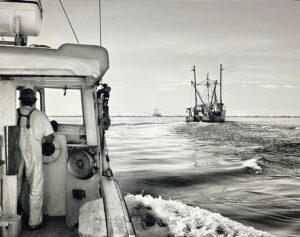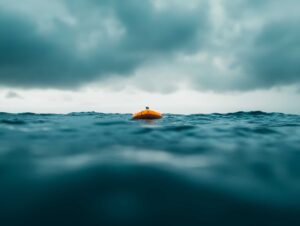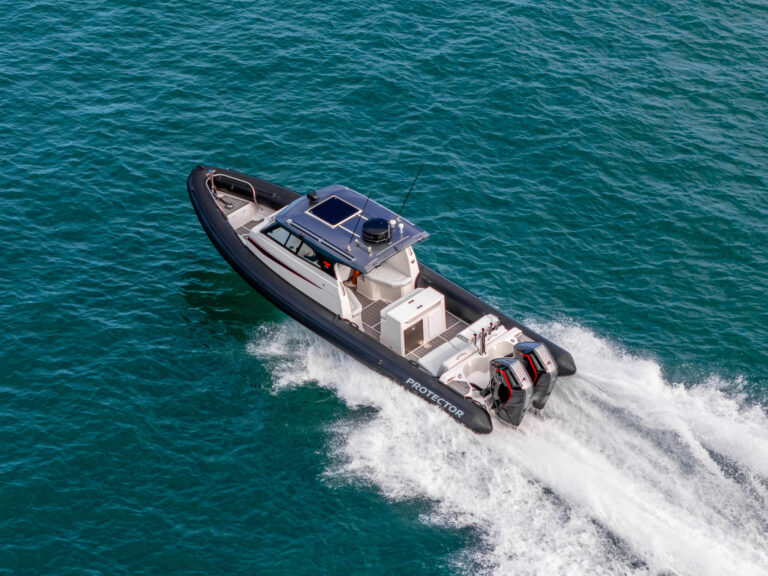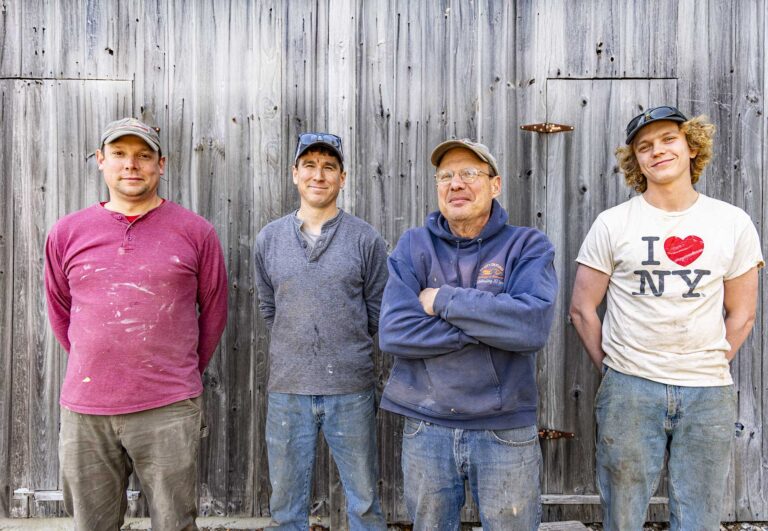Mussel Ridge lobster yachts are a fan favorite among commercial fishermen, who appreciate their wide beams, quality construction and proven seagoing performance. These boats hail from Hutchinson Composites in Cushing, Maine, where Albert Hutchinson has carved out a niche for himself building bare hulls and decks for commercial fishing. They are then finished by other boatyards around Maine. Not all are built for fishing, though. Consider Pretti Rose, a Mussel Ridge 54. The massive, open cockpit reflects her commercial lineage, but this Downeaster is anything but a rugged fishing boat. She is a trimmed-out recreational vessel with a comfortable interior designed by Newport Yacht Builders in Newport, Rhode Island.
The boat’s owner, Eli Dana, calls Pretti Rose his “brainchild.” Having grown up on his family’s two wooden lobster boats, he has always had an affinity for Downeast designs. He owned a Holland 38 as an adult, and while he loved it, he wanted to build a bigger and newer vessel out of fiberglass. So, he started brainstorming with Ezra Smith, the designer at Newport Yacht Builders and principal of Ezra Smith Design.
“He wasn’t even sure he was going to build a boat yet,” Smith says, although he had developed a keen interest in Mussel Ridge hulls. Smith and Dana worked in close proximity—Smith’s office is in a building at Newport Shipyard, where Dana works as the general manager—so it was easy for them to sit behind Smith’s computer and throw around ideas. “Once we got to something Eli was really excited about, he said ‘let’s do this.’ We started talking with Hutchinson Composites about getting a hull, and it all went from there,” says Smith.

The Pretti Rose project was the first new build for Newport Yacht Builders, a group consisting of Smith, builder Jim Thompson and project leader Ashley Reville Hill. The group formally came together in 2018, but the members have been working on projects together for over a decade. Now, they are refining a production process for designing and installing interiors, furniture and systems that utilizes laser scanning and CNC cutting to expedite the construction process.
“Jim and I had done a few pretty big projects together and were always thinking, how can we do this better?” says Smith. “We were putting interiors in existing spaces, and the missing part of the puzzle was accurately recording the envelope we were designing, so we were interested in scanning technology before it was even particularly commercially viable.”
In 2017, Hill and Thompson started CaptureRI, a 3-D interactive scanning company, which utilized a RTC360 laser scanner capable of scanning bare hulls. This technology was the missing piece that Smith and Thompson had been looking for, as it moves projects straight from scan and design over to CNC cutting for manufacturing,
saving time and labor. The three of them decided to join forces and pool the resources of their individual companies to go after bigger boatbuilding projects.
In the beginning, the group worked primarily on refit projects while they refined their production process, starting with the 136-foot Consolidated motoryacht. They redesigned the yacht with new crew spaces, modifications to guest spaces, new deck furniture, a new bridge interior and a new captain’s cabin. Using old photographs, structural drawings and exterior hull scans taken years before by Andrew Williams, the pioneer of laser scanning in the marine industry, they were able to interpret the interior space and then cut and assemble frames in Thompson’s shop, which is located just feet away from the offices of Smith and Hill.
The next project was the 93-foot motoryacht Contraband, launched by New England Boatworks in 2018, for which Smith created the interior layout. He worked out the basic dimensions with 2-D drawings, which he then used to create a 3-D model of the space. Then, he scanned the actual space and integrated the scan with the 3D model, eliminating the need for on-site templating. Thus, they were able to build all of the furniture components off site.
“These were all the steppingstones,” says Smith of the prior projects. “With Pretti Rose, we really brought it all together, and used our process A-to-Z.”
Once Dana had spoken with Hutchinson about building a 54-foot Mussel Ridge, Smith developed a 3-D model of the interior using specs from the designer. Then, to ensure that model was as accurate as possible, Thompson went to Maine while the boat was still in the mold and scanned the inside hull surface. Smith dropped that scan into his 3-D model and trimmed his surfaces to match the actual skin of the boat. This allowed the team to build all of the interior components—including bulkheads, soles and furniture—in the shop before the hull even made it to Rhode Island.

“While the hull was being built, we were building here, so it was a huge timesaver,” says Hill. Normally, Smith explains, when you get the hull into the shop, the crew starts templating by hand, transferring the templates onto the parts, and cutting the parts. Laser scanning eliminates this part of the process, allowing the team to get accurate shapes on the computer, with a 3-mm tolerance for bonding and fiberglass. Afterward, they cut pieces to a very fine degree with the CNC machine, assembled them on the shop floor and drop- ped the finished parts into the boat.
On Pretti Rose, the result, the team estimates, was a 30 to 50 percent savings in man-hours. Rather than it all having to be a linear build process, everyone is doing their part simultaneously, says Smith. “We were pioneering this whole thing as we were doing it, and we definitely saw the benefits.”
After the hull arrived, Pretti Rose was put together and in the water in just five months, and that was in the midst of a global pandemic. The custom yacht was delivered to Dana faster than most buyers were getting their production boats.
Pretti Rose is built on a commercial hull and enjoys the performance benefits of her Down East design, but her interior is entirely yacht-like. Herreshoff styling, with white paint and dark wood, makes the space feel bright and modern, while traditional touches—like the vintage ship’s wheel from Rosebank Ironworks Edinburgh—suit her
classic lines.
Newport Yacht Builders made some interesting and practical layout choices. The cockpit is entirely empty aside from an aft bench seat and a small sunpad near the pilothouse. This created enough space to install slides in the deck, so the aft bench can roll forward to open the transom, and the sunpad can roll aft for engine room access. The generator and single 1,550-hp diesel MAN V-12 engine with V-drive transmission are both located beneath the cockpit to keep things quiet in the
pilothouse.

While Pretti Rose’s clean cockpit design resembles her workhorse ancestors, the pilothouse is designed for entertaining and livability. With a beam of 17 feet, 4 inches, there is ample space for a social galley-up design, with generous counter space, large appliances and a deep double sink. Next to the galley is an L-shaped lounge with dinette, positioned directly behind the helm station.
In the cabin, the master stateroom is in the bow, and a smaller stateroom with twin berths is to port. The head is roomy, with easy access to the boat’s systems through the shower. There is also a second head, accessed through the cockpit, that leads into the third stateroom, which could be used as captain’s quarters.
Perhaps the most practical features on Pretti Rose are her bow and stern thrusters, which make it easy to maneuver the boat away from the dock. With the MAN V-12, Pretti Rose cruises at 20 knots and runs 23 knots at top end.
Pretti Rose splashed in May of 2021, and Dana has been cruising her locally with his family since August. For Dana, however, this project wasn’t about building a family cruiser; it was about taking an interesting concept and bringing it to life. Now that Newport Yacht Builders has turned his vision into reality, he plans to sell the boat and build another.
The team is now working on another Mussel Ridge boat as well, a 46 that will be designed as a sportfisherman with a straightforward trim package. Says Smith, “We’ve learned so much with Eli’s boat, and now we want to sharpen our pencils and see how efficiently and cost-effectively we can do this.”
LOA: 54’0”
Beam: 17’4”
Displ.: 50,000 lbs.
Draft: 6’0”
Power: (1) 1,550-hp MAN V12-1550CR diesel engine
This article was originally published in the April 2022 issue.










